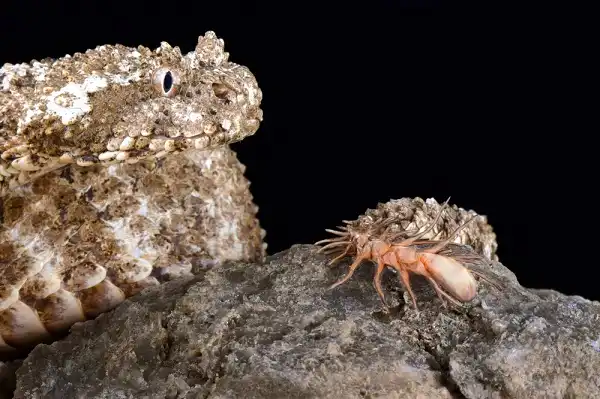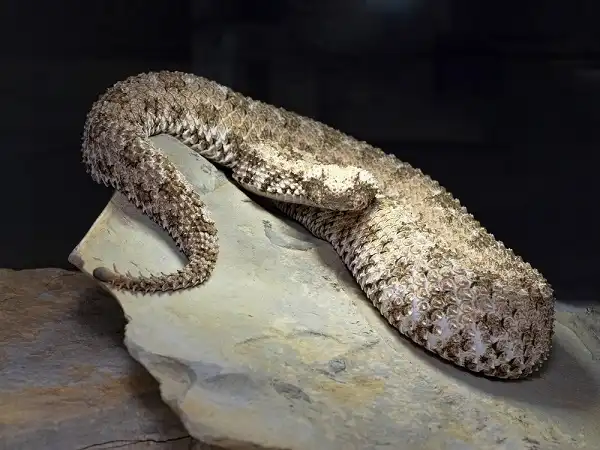Have you ever heard of the spider tailed horned viper? This impressive snake is found in Western Asia and can be identified by its unique tail – it’s actually shaped like a spider! Despite their intimidating appearance, these remarkable reptiles are incredibly fascinating creatures with several interesting behaviors. Read on to discover why the spider tailed horned viper has become one of the most beloved snakes among herpetological enthusiasts all around the world.

Spider Tailed Horned Viper Description
The spider-tailed horned viper is a mesmerizing species of snake. The spider-tailed horned viper’s camouflaged appearance, coupled with its stealthy movements, make it an undetectable hunter. One of the most striking features of the spider-tailed horned viper is its impressive horn-like projections on top of its head. This characteristic has lent the snake its name – the “horned” viper. These horns are thought to be used both for sensing vibrations in the environment and for defense against predators.
Spider Tailed Horned Viper Habitat
The spider-tailed horned viper is an elusive and fascinating reptile that calls the rocky terrain of Western Asia it’s home. These snakes can be found in a variety of habitats, from arid desert regions to rocky hillsides and mountains at elevations of up to 2,500 meters. They prefer a rocky terrain that can provide them with shelter and protection from both predators and extreme weather conditions. The spider-tailed horned viper is a master of camouflage, and can often be difficult to spot against rocky terrain. While the spider-tailed horned viper is not typically aggressive towards humans, the loss of their natural habitat and the threat of poachers puts their survival in jeopardy. Their unique and remarkable appearance has made them a target for collectors and trophy hunters, and their numbers are declining rapidly. It is crucial that measures are put in place to protect these fascinating creatures and preserve their natural habitat.
Spider Tailed Horned Viper Diet
The spider-tailed horned viper is a fascinating reptile that is not only known for its impressive physical traits but also for its unique dietary habits. As an opportunistic hunter, this species has a varied diet that includes insects, small mammals, and reptiles. Insects are also a common target for the spider-tailed horned viper, and these snakes are able to catch and consume them with remarkable ease. Small mammals, such as rodents and birds, also make up a portion of the spider-tailed horned viper’s diet. While these prey sources are less common than lizards and insects, the viper is still able to take them down with its impressive hunting skills. Interestingly, the spider-tailed horned viper is also known to occasionally consume other snakes, including members of its own species. This is a unique behavior that is not often seen in snakes and could be a result of their aggressive and solitary nature.
Spider Tailed Horned Viper Size
The spider-tailed horned viper is a fascinating creature not only because of its impressive hunting skills and unique appearance but also because of its size. This species is smaller than some of its snake cousins, with an average length of around 70 cm (27 inches) and a weight of about 100 grams (3.5 ounces). Despite its relatively small size, the spider-tailed horned viper is a formidable predator. Its thin and agile body allows it to move quickly and navigate through the rocky terrain of its natural habitat with ease. Its long fangs, which can reach up to 5 mm (0.2 inches) in length, are perfectly suited to catching and injecting venom into prey items. As with other reptiles, the spider-tailed horned viper’s size can vary depending on its geographic location and other factors. For example, some specimens found in Iran have been recorded as being as long as 92 cm (36 inches), while others in different regions may only grow to around 40 cm (16 inches).

Spider Tailed Horned Viper Lifespan
The spider-tailed horned viper’s lifespan is not well known, as the species has not been extensively studied in the wild. However, it is estimated that these snakes can live for up to 20 years in captivity. In the wild, the lifespan of the spider-tailed horned viper is likely shorter due to a number of factors, including predation, disease, and competition for resources. These snakes are also relatively slow to reach sexual maturity and may take several years before they are able to reproduce. Unfortunately, habitat loss and degradation, as well as the ongoing trade in exotic pets, are major threats to the spider-tailed horned viper’s survival. Conservation efforts are needed to protect this remarkable species and ensure its continued existence for generations to come.
Spider Tailed Horned Viper Behavior
The spider-tailed horned viper’s behavior is as fascinating as its appearance and hunting skills. These snakes are solitary creatures, preferring to live and hunt alone in their rocky and arid habitats. They are most active during the day, but may also hunt at night if the temperature is mild. Interestingly, the spider-tailed horned viper has been observed to “play dead” when threatened. When confronted by a potential predator, the snake will contort its body into a still position, mimicking the appearance of a dead snake. This behavior is thought to be an adaptation to avoid detection by predators that may be attracted to movement. Despite their formidable hunting skills, spider-tailed horned vipers are not aggressive toward humans unless provoked. However, their venom can be highly toxic, and a bite from this snake can be fatal if left untreated. During the mating season, male spider-tailed horned vipers will engage in ritualized combat to win the favor of a female. These battles can be highly aggressive, with the males pushing and grappling with each other in an attempt to assert dominance.
Spider Tailed Horned Viper Speed
The spider-tailed horned viper is a relatively slow-moving snake, despite its impressive agility and agility. These snakes typically travel at a leisurely pace of about 1.2 miles per hour when searching for prey or navigating their rocky and arid habitat. However, these snakes can reach speeds of up to 3 mph when pursuing a potential meal. This is quite fast considering the terrain they inhabit; however, it’s still slower than many other species of snake. The spider-tailed horned viper’s relatively slow speed is a crucial part of its survival strategy. It allows the snake to remain undetected while it surveys its environment and prepares for an ambush attack if necessary. This behavior has allowed this species to thrive in some of the world’s most difficult environments, such as deserts and rocky hillsides.

Spider Tailed Horned Viper Hunting
The spider-tailed horned viper is a master of hunting techniques that have evolved to allow it to thrive in the harsh conditions of its rocky, arid habitat. One of the most fascinating hunting skills of this remarkable snake is its ability to exhibit patience and stealth while preparing to ambush its prey. While spider-tailed horned vipers are not known for their speed, they are nonetheless impressive predators. These snakes use their agility and powerful muscles to launch themselves with lightning speed at their prey. Once within range, they strike with their venomous fangs, delivering a potent cocktail of toxins that can quickly incapacitate or kill their victim. One of the most unique aspects of the spider-tailed horned viper’s hunting style is its reliance on ambush tactics. These snakes have adapted their behavior to take advantage of the rocky terrain and arid climate of their environment. By blending in with their surroundings and remaining motionless for extended periods, they are able to remain undetected by their prey until it is too late.
Spider Tailed Horned Vipers Reproduction
The spider-tailed horned viper reproduces through ovoviviparity, meaning that the eggs are retained inside the mother until they hatch. The female will give birth to a litter of up to 10 live young after an average gestation period of 9 months. These snakes reach maturity at between 18 and 24 months old, depending on food availability in their environment. Due to their unique habitat requirements, spider-tailed horned vipers require specific conditions for successful reproduction. Females will often seek out areas with dense vegetation or rocky crevices that provide adequate cover from predators and environmental extremes. Males tend to be significantly more active during mating season and can often be heard making vocalizations as part of their courtship rituals.
Spider Tailed Horned Viper Venom and Danger to Humans
The venom of the spider-tailed horned viper is highly potent and can cause severe symptoms in humans if a bite occurs. Common effects include intense pain and swelling around the area, nausea, vomiting, rash, fever, and dizziness. In extreme cases, it can lead to paralysis or even death if medical treatment is not sought immediately. As with all wild animals, it is important to remember that the spider-tailed horned viper should be treated with respect and caution when encountered in its natural habitat. Human interference should be avoided whenever possible as these snakes are sensitive to disturbances in their environment. If you find yourself in close proximity it’s best to remain still, back away slowly, and never attempt to handle the snake.

Conclusion
The spider-tailed horned viper is an amazing species that is both unique and impressive in its adaptations and hunting behavior. From its ability to blend into the environment to its remarkable speed and agility, this snake is a masterful predator that has evolved to take advantage of the rocky desert landscape it calls home. Its venomous bite can also quickly incapacitate or kill its prey, making it a formidable force in the animal kingdom. In order to protect and preserve this extraordinary species, we must continue our efforts to better understand its biology and ecology as well as work towards the conservation of their natural habitats. As one of nature’s greatest predators, the spider-tailed horned viper deserves our respect and admiration for all it offers our world.
Frequently Asked Question


